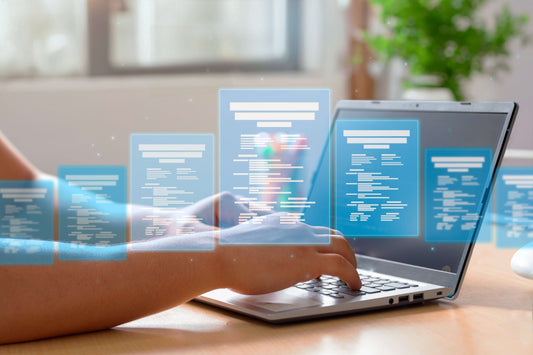As organizations push toward sustainability, cost reduction, and ESG compliance, Digital Twin technology has emerged as one of the most powerful tools for optimizing resources in the built environment. From commercial buildings to airports and multi-site enterprises, digital twins provide a digital replica of buildings and assets to help leaders make smarter, data-driven decisions.
Modern digital twins, powered by IoT sensors, AI analytics, and cloud simulation engines, have evolved far beyond visualization. They now function as AI-driven operational intelligence platforms, helping organizations reduce energy waste, predict failures, enhance occupant comfort, and track carbon emissions with accuracy.
According to a McKinsey report, AI-enabled operational technologies can improve infrastructure efficiency by up to 30%.
By combining sensor data with AI models, organizations can test “what if” scenarios before changing anything in the real world, saving money and reducing waste.
1. Digital Twin for Buildings: Optimizing Energy & Operations
Today’s smart building digital twin solutions provide deep insights into energy consumption, HVAC performance, and occupant behavior.
Where It Optimizes Resources:
- Reduces HVAC energy use by analyzing thermal loads
- Automates ventilation and chiller schedules via IoT-powered digital twin
- Simulates solar gain, lighting, and occupancy through building energy simulation
- Identifies anomalies and inefficiencies with building analytics AI
- Enables AI-powered facility optimization for FM teams
For example, by using a digital twin for energy savings, a commercial building can reduce cooling energy by 15–30% simply by adjusting airflow, setpoints, and occupancy-based scheduling.
Key Benefits:
- Lower electricity bills
- Reduced carbon footprint
- Improved occupant comfort
- Higher equipment life
- Lower operational risk
2. Digital Twin for Energy: Predictive & Carbon-Focused Optimization
Global decarbonization goals are pushing enterprises to use Digital Twin for Energy management. This includes:
- Predictive energy analytics to forecast peak loads
- Renewable integration simulation
- Carbon footprint tracking software
- Digital twin for carbon reduction strategies
By modeling every kWh consumption pattern, companies can test how operational changes impact ESG outcomes. Combined with an ESG reporting platform, this ensures transparency and accuracy in sustainability reporting.
3. Digital Twin for Airports: Smarter, Safer, and More Efficient Operations
Airports are complex ecosystems with terminals, runways, cargo areas, utilities, and movement systems. A Digital Twin for Airports provides a 360° operational view, helping leadership improve reliability, safety, and efficiency.
Use Cases:
- Simulate passenger flow using an airport operations digital twin
- Predictive maintenance for baggage systems, chillers, escalators, and AHUs
- Building performance simulation for terminals
- Operational scenario testing for emergency responses
- Energy and HVAC optimization across multiple terminals
With real-time operational simulation, airports can detect bottlenecks before they occur and reroute resources efficiently.
4. Multi-Site Digital Twin Platform: Enterprise-Wide Optimization
For retail chains, hotels, universities, or global corporate campuses, a multi-site digital twin platform offers centralized visibility and control.
Capabilities:
- Compare energy performance across locations
- Standardize facility workflows
- Automate reporting on energy and emissions
- Benchmark maintenance KPIs
- Deploy AI-driven optimization universally
A single dashboard helps identify which buildings underperform and why, enabling quick corrective action.
5. Facility Management Digital Twin: Proactive Instead of Reactive
Traditional facility management relies heavily on manual inspection and time-based maintenance. A facility management digital twin revolutionizes this model through real-time sensor data.
Examples:
- Predict structural issues via vibration patterns
- Assess indoor air quality and temperature distribution
- Monitor chiller and boiler performance
- Trigger alerts using predictive maintenance AI
The biggest value lies in accelerated ROI, as teams spend less on emergency repairs and more on strategic improvements.
6. Smart Building Operations Optimization Through AI
A digital twin platform integrates building systems — HVAC, lighting, lifts, fire safety, water pumps into a single intelligent layer.
- Automated setpoint optimization
- Occupancy-based climate control
- Dynamic lighting control
- Peak load shifting
- AI-based fault detection
It also supports real-time BMS data integration and IoT building automation for large campuses.
7. Carbon Reduction, ESG, and Compliance
With growing climate responsibility, digital twins provide accurate tools to track energy and carbon performance, enabling:
- Carbon footprint tracking
- Renewable energy planning
- Automated ESG reporting
- Scenario-based carbon reduction strategies
This ensures companies meet national mandates and global sustainability standards.
The Future: AI Digital Twin for Commercial Buildings
We are entering an era where buildings learn, self-adjust, and self-optimize. The AI digital twin for commercial buildings enables:
- Autonomous HVAC optimization
- Self-learning building controls
- Fully automated predictive maintenance
- Continuous building performance simulation
- End-to-end operational scenario testing
These systems will make buildings significantly more efficient, sustainable, and adaptive.
Conclusion:
Digital Twins are the Key to Sustainable & Cost-Efficient Infrastructure
They are transforming how organizations manage buildings, energy & operations. Whether you’re managing a single commercial building, an airport or a multi-site enterprise, a powerful digital twin platform delivers:
- Lower energy usage
- Reduced operational costs
- Enhanced asset life
- Real-time insights
- Measurable carbon reduction
- Improved ESG compliance
In an era where sustainability and efficiency drive competitive advantage, digital twin technology is no longer optional, it’s essential.
Explore more insights on Digital Twin










